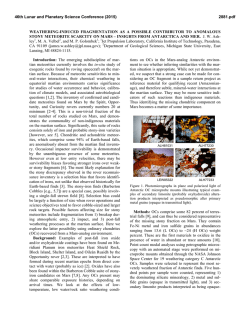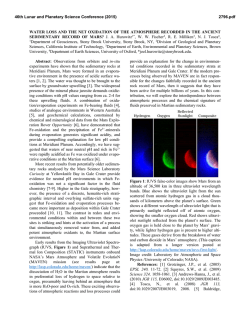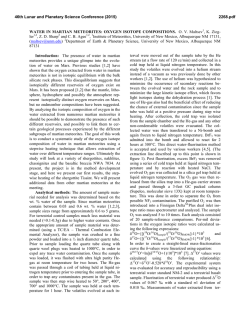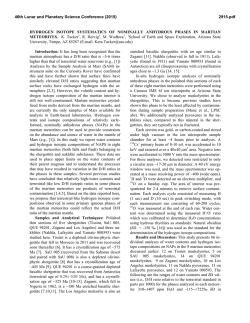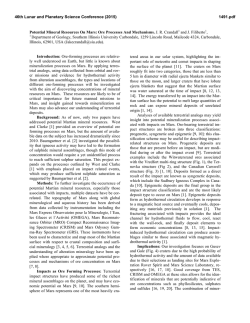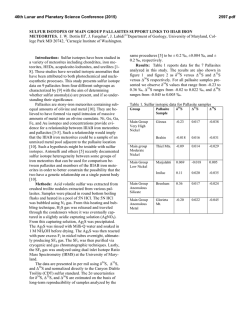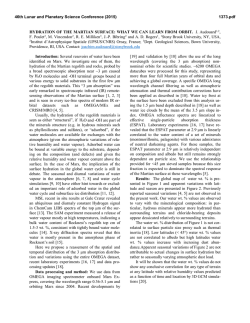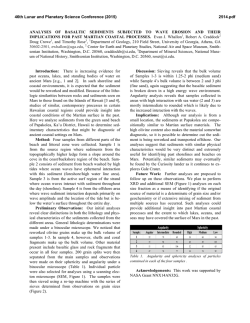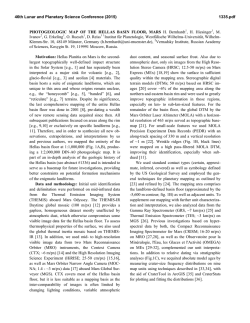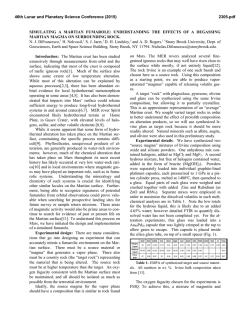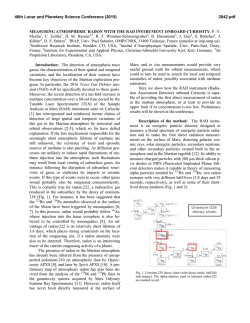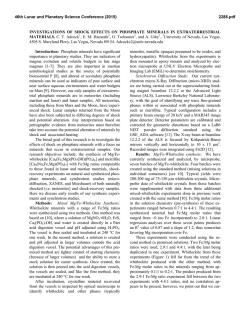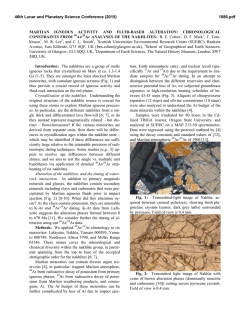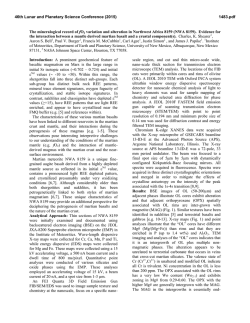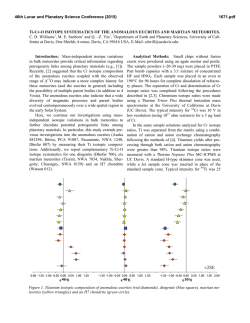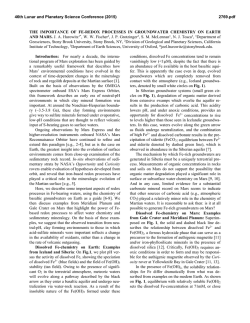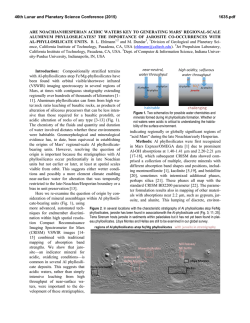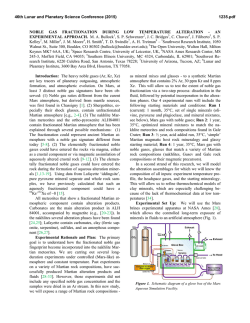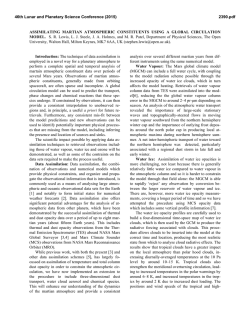
SULFUR ISOTOPES AND MARTIAN CLIMATE HISTORY . H. B.
46th Lunar and Planetary Science Conference (2015) 2970.pdf SULFUR ISOTOPES AND MARTIAN CLIMATE HISTORY . H. B. Franz, CRESST/UMBC, NASA Goddard Space Flight Center, Code 699, Greenbelt, MD 20771, [email protected]. Introduction: Martian meteorites have revealed evidence for incorporation of some crustal material into magmas, providing a mechanism for preserving signatures of surface processes into igneous rocks. Fortunately, some of these rocks have since endured the improbable journey of launch from Mars through ultimate landing in terrestrial laboratories, where they continue to serve as vital specimens for high-precision study of our neighboring planet [e.g., 1-4]. Studies focused on the isotopic composition of sulfur-bearing minerals in the meteorites have revealed clues to the type of sulfur chemistry that occurred in the martian atmosphere, which carries implications for Mars’ climate history [5-6]. The martian surface as climate record: Due to the absence of large-scale crustal recycling on Mars, the planet’s surface maintains geochemical records dating throughout its history [7]. Variations in mineralogy and topography provide a basis for definition of three major historical periods – Noachian, Hesperian, and Amazonian – and suggest that these periods were dominated by different environmental conditions [8-9]. The Noachian period, from ~4.1 to 3.7 Ga [10-12], is the one most closely associated with water activity. The prevalent impacts of the pre-Noachian period, which may have produced the crustal dichotomy [1315] and released substantial quantities of volatiles into the atmosphere [16], transitioned to the Noachian, characterized by continued impacts, high rates of erosion, formation of extensive valley networks, and rise of the Tharsis volcanic province [17-18]. Noachian terrain displays evidence for widespread phyllosilicate minerals, implying the presence of liquid water and alkaline pH [19]. However, it is uncertain whether the formation of the valley networks and phyllosilicates required atmospheric conditions that sustained a warm, wet surface environment for periods of time or if these features were formed by action of groundwater, which would have been less dependent on prevailing climate [e.g., 17-21]. Martian greenhouse effect: Scenarios characterized by periods of warm, wet surface conditions on Mars require operation of some type of greenhouse effect to maintain temperatures above the freezing point of water. The possibility of warming by a thick CO2 atmosphere is problematic due to the lack of evidence for sufficient loss process or surface sink to reach the current abundance level [17]. Alternative hypoetheses have invoked the presence of trace gases, such as SO2, OCS, and H2S, to achieve the required warming effects [e.g., 22-26]. The potential for sulfur- bearing gases to produce a greenhouse effect is limited by overall atmospheric chemistry, however. For example, the warming effect of SO2 is moderated by a competing cooling effect due to increase in planetary albedo upon formation of sulfate aerosols [27]. The concentration of SO2 in the atmosphere would determine whether a warming or cooling effect was dominant at any given time [27]. Sulfur isotopes as a climate tracer: Sulfur has proven to be a valuable tracer for a variety of geological processes due to its four stable isotopes (32S, 33S, 34 S, and 36S)1 and chemical properties. The importance of sulfur to atmospheric studies lies in the behavior of its isotopes during certain processes, such as UV photochemical reactions, that fractionate the isotopes in ways that are not predicted solely by classical, massdependent selection rules [28]. This behavior is often referred to as sulfur mass-independent fractionation, or S-MIF. Signatures of atmospheric processes may thus be transferred to the rock record and preserved in sulfur-bearing mineral phases [29]. S-MIF signatures have been observed in samples from both Earth and Mars [5-6, 29]. On Earth, the cessation of S-MIF signals ~2.1 Ga is interpreted as evidence for a major change in oxidation state of the atmosphere [29]. Gas-phase photochemical experiments with SO2 have characterized the nature of sulfur isotopic fractionation in the UV and yield good agreement with the signature observed in ancient terrestrial samples [28-30]. Studies of sulfur extracted from martian meteorites have also found S-MIF signatures in both oxidized and reduced mineral phases (Figure 1), interpreted as evidence for atmospheric photochemistry on Mars that was preserved in the rock record [5-6]. However, the relationship between the minor sulfur isotopes in martian samples is different from that observed in ancient terrestrial samples, suggesting that the dominant sulfur chemistry of the martian atmosphere was different from that of early Earth [6]. The same signature has been observed in meteorites extending from the oldest (ALH 84001, ~4.1 Ga) to the youngest (shergottites, ~150500 Ma), suggesting that the same photochemical pro1 Sulfur isotopic compositionsare generally reported as 34S, 33S, and 36S, representing the deviation of isotope ratios in the sample compared to a standard. We use the following definitions: 33S = 33S-1000 [(34S/1000+1)0.515-1] 36S = 36S-1000 [(34S/1000+1)1.9-1] 46th Lunar and Planetary Science Conference (2015) cess has prevailed on Mars throughout its history. The span of S-MIF signatures observed among different types of meteorites, such as nakhlites compared to shergottites, may indicate that complementary sulfur pools were preserved in these parent rock units, or it could indicate differences in dominant preservation pathways at one geographic locale or time versus the other [6]. Figure 1. 33S vs. 36S for martian meteorites. Diamonds are nakhlites, square is Chassigny, circles are ALH 84001, and triangles are shergottites. Approximate S-MIF trend observed in terrestrial samples is indicated as “Archaean reference slope.” Figure adapted from [6]. Decoding Mars’ photochemical signature: Comparison of the martian S-MIF signature with that of ancient Earth and those produced in laboratory photochemical experiments suggests that a different mechanism was responsible for producing the signal recorded in martian rocks [5-6, 28-30]. The optically thick SO2 columns employed in laboratory experiments to date yield a close match to the S-MIF signals in the terrestrial rock record [28-30], but not that seen in martian meteorites [5-6]. This observation, combined with modeling of the SO2 absorption spectrum [30], suggesting that the martian atmosphere has not been dominated by high abundance of SO2 [6]. Climate models invoking greenhouse warming by SO2 on early Mars should take this into account. References: [1] McSween (1994) Meteoritics 29. [2] Jones (1989) Proc. of 19th LPSC, 465-474. [3] Rumble and Irving (2009) LPSC XL, #2293. [4] Farquhar and Thiemens (2000) JGR 105. [5] Farquhar et al. (2000) Nature 404. [6] Franz et al. (2014) Nature 508. [7] Bibring and Erard (2001) in Chronology and Evolution of Mars, Kallenbach et al., eds. [8] Scott and Carr (1978) USGS, Misc. Invest. Ser. Map I-1083. [9] Tanaka (1986) JGR 91. [10] Frey (2008) GRL 35. [11] Fassett and Head (2011) Icarus 211. [12] 2970.pdf Hartmann and Neukum (2001) in Chronology and Evolution of Mars, Kallenbach et al. [13] Wilhelms and Squyres (1984) Nature 309. [14] McGill and Squyres (1991) Icarus 93. [15] Nimmo et al. (2008) Nature 453. [16] Segura et al. (2002) Science 298. [17] Carr and Head (2010) EPSL 294. [18] Phillips et al. (2001) Science 291. [19] Bibring et al. (2006) Science 312. [20] Pollack et al. (1987) Icarus 71. [21] Ehlmann et al. (2011) Nature 479. [22] Kasting et al. (1989) Orig. Life Evol.Biosph. 19. [23] Squyres and Kasting (1994) Science 265. [24] Halevy et al. (2007) Science 318. [25] Johnson et al. (2008) JGR 113. [26] Johnson et al. (2009) JGR 114. [27] Tian et al. (2010) EPSL 295. [28] Farquhar et al. (2001) JGR 106. [29] Farquhar et al. (2000) Science 289. [30] Franz et al. (2013) Chem. Geol. 362.
© Copyright 2026

